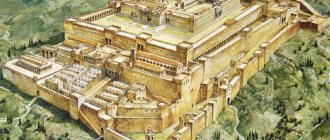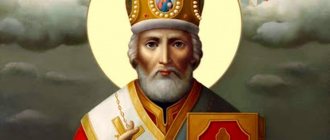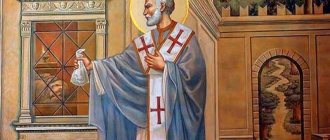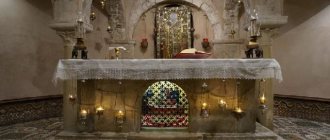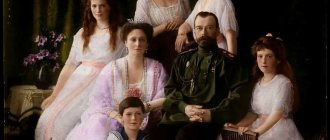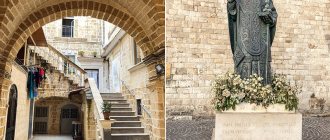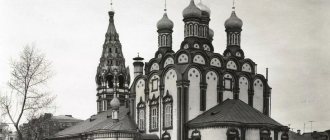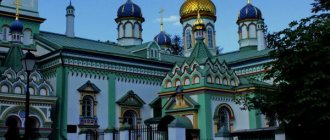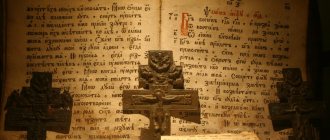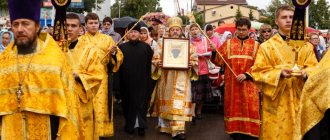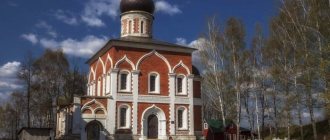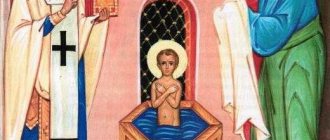One of the most tragic pages in the history of Russia in the 20th century was the murder of the royal family, dictated, as the Bolsheviks claimed, by “revolutionary necessity.” The victims of this inhuman logic were not only Nicholas II, who became the last representative of the three-hundred-year-old Romanov dynasty, but also his wife, Empress Alexandra Feodorovna, their four daughters aged from 17 to 23 years and the heir to the throne, 14-year-old Tsarevich Alexei. People who remained faithful to them in this last hour were also killed: both family members and those from their immediate circle.
History of the icon
The sin of murdering God’s anointed one weighed heavily on Russia for many decades, and only at the turn of the millennium, in 2000, the murdered Emperor Nicholas II and his family were canonized by the Russian Orthodox Church as royal martyrs. To glorify the new saints, icons of the Romanov royal family appeared.
However, the icon of the Romanovs serves not only to glorify the innocent murdered, but also for the repentance of the people guilty of the sin of apostasy from God’s anointed and leaving him along with innocent children in the hands of enemies. This sin is aggravated by the fact that neither the family nor those close to them during the arrest and detention tried to resist, humbly accepting the Will of God with Christian meekness. This sin, which still weighs heavily on Russia, will have to be atone for more than one generation.
Therefore, it is not surprising that today the icon of the holy royal passion-bearers is in almost every Orthodox church, and many believers have it in their homes. This is the meaning of the icon of the royal martyrs - to remind all of us, both believers and non-believers, of the martyrdom of the royal family, which was accomplished in the name of peace on Russian soil and once again confirmed the inviolability of the foundations of Orthodoxy in the Russian state.
About the miraculous image of the Sovereign Emperor Nicholas II
The miraculous myrrh-streaming image of the Tsar-Martyr Nicholas II has a keeper - Moscow surgeon Oleg Ivanovich Belchenko. He travels with her to churches and monasteries when his busy work schedule allows, at other times he is helped by people who care for the image. Small paper icons are printed with the money of private benefactors, and the proceeds from their distribution go to the production of large icons, which Oleg Ivanovich gives to churches with the hope that each church will soon have its own icon of the Sovereign.
Oleg Ivanovich, please tell us the story of the painting of the icon of the Tsar-Martyr Nicholas.
A sad paradox of the 20th century: the icon of the last Russian emperor, martyr Nicholas II, was painted on the other side of the ocean, in the United States of America, even before the glorification of the Tsar in Russia.
And there is an amazing story connected with this event. The year was 1997. The Russian emigrant Iya Dmitrievna Shmit, nee Podmoshenskaya, had a dream in which she saw an icon depicting the martyr Emperor Nicholas II in grand ducal attire. A few days before, the woman received a small inheritance and was going to contribute to a good cause. Upon awakening, the question of what to donate the money to was resolved for her. She asked the icon painter Pavel Nikolaevich Tikhomirov, who lives in California, to paint the icon she saw. Together they began to study photographs of Nicholas II in search of a plot and the same facial expression as in the dream. The king was supposed to wear Monomakh's hat, with a scepter and orb.
On the left of the icon is depicted the righteous Job the Long-Suffering, on the day of whose memory Nicholas II was born, on the right is the heavenly patron of the Sovereign, St. Nicholas the Wonderworker. And below is the inscription: “This holy icon was written for the glorification of the Martyr Tsar in Russia.” And this was several years before the canonization of the Royal Martyrs.
The icon itself is still kept at Iya Dmitrievna’s home. She began selling lithographs made from it to help Russian people who found themselves in difficult situations abroad.
How did the image appear in Russia?
Abbot Herman (Podmoshensky), Iya Dmitrievna’s brother, brought with him several images. One of the color lithographs of the icon ended up in the St. Nicholas almshouse in Ryazan. It was inserted into the icon case and hung behind the candle box. There I first saw this image. On that spring day, I helped my friend bring boxes of spiritual literature to the almshouse. The books were donated free of charge, and in gratitude my friend and I were each given the same lithograph. This happened on March 15, 1997 - exactly eighty years after the Tsar was forced to sign an act of abdication.
For a year and a half, the lithograph of the Tsar’s icon was kept in my home. But gradually I began to notice changes happening to her. First, a spot appeared under the Tsar’s right eye, as if it was blood, then the same spot appeared under his left eye. The colors gradually changed. I turned to the priest, and he suggested taking the image to the church. That's what I did. On September 6, 1998, I brought the image to the church of the Sretensky Monastery, of which I was a parishioner. I couldn’t put the plastic bag in which the icon was on the table, so I held it in my hands.
In those years, the Emperor had not yet been glorified, but then, completely unexpectedly for me, the priest asked the choir to sing a troparion to the Martyr Tsar... People in the church began to turn around and look in my direction. And I couldn’t understand what was happening. It turned out that with the singing of the troparion a fragrance spread throughout the temple. And because of the runny nose, I was the only one who didn’t feel it.
After the service, I took out the lithograph, and the fragrance only intensified. The parishioners divided the package into pieces among themselves - and now, years later, these scraps continue to emit a smell. Everyone was shocked, and the priest said: “Let us hold this icon in our altar, and then we’ll see what to do.”
I was delighted.
Of course, the icon of the Emperor should be in the altar. But, I repeat, at that time the Royal Martyrs had not yet been glorified as saints. Three weeks later I asked the priest: “Does she still smell fragrant?” “Yes, it smells fragrant,” he replied. “And what will happen next? Maybe I should put it on the lectern or should I still take it?” The priest consulted with someone and said: “Take it.” And the image began to move from temple to temple, traveling throughout Russia?
Yes. At that time, Hieroschemamonk Rafail (Berestov) arrived in Moscow. I approached him with a request: “Father, determine the fate of this icon. If you tell me to take it to some temple, I’ll take it, tell me to keep it at home, I’ll keep it at home.”
Father Raphael looked at the lithograph for a long time, and then answered: “This is a kind of myrrh-streaming. The droplet does not have time to form and evaporates, but the smell remains. Don’t worry, it will still flow visibly.” Then he remarked: “Don’t rush to assign her to some temple. The Emperor has not yet been canonized. But the Lord will tell you what to do with it. And if you want to hear my advice, then carry it around the temples and where they agree to place it on a lectern, leave it for a while.” This advice was later repeated almost word for word by Archpriest Nikolai Guryanov and Archimandrite Kirill (Pavlov): where the believers will worship, leave the image.
Thus, with the blessing of Hieroschemamonk Raphael, the miraculous lithograph of the icon began its journey through churches and monasteries. More than 20 dioceses accepted the image of the Martyr Tsar before his glorification at the Council of Bishops in 2000.
The icon began to move from temple to temple. At first they brought her to the Novodevichy Convent, where Mother Seraphima (Chichagova) was then abbess. When I took the image, I forgot the diplomat in the monastery. Approaching the metro, one of my companions said: “Something unusual is happening. A trail of fragrance trails behind you.” The frost was severe. We stopped, took the lithograph out of the bag and saw that its case was completely saturated with the world. Then a nun caught up with us, and her first words were: “I followed the smell, the fragrance is from the monastery.” Then she gave me the diplomat.
When did visible myrrh-streaming begin?
For some time, the image was kept by a parishioner, a friend of mine. On November 7, 1998, I went to see her and saw a drop of amber-colored myrrh flowing down the icon... The words of Father Raphael came true that the myrrh would flow out visibly. For some unknown reason, it flowed not immediately from top to bottom, but first horizontally, against all the laws of gravity.
A monk I knew from the Solovetsky Metochion arrived and, having collected a few drops, said: “Today there will be an all-night vigil, I will mix this ointment with oil and anoint it with it.”
A week later, the image was received in the Church of the Ascension of the Lord on the Pea Field. Almost every day the lithograph streamed myrrh, akathists were read before it, and this continued for several months. On February 28, 1999 - it was the day of the Triumph of Orthodoxy - the image was transferred to the Church of St. Nicholas the Wonderworker in Pyzhi. Archpriest Alexander Shargunov agreed to receive him with great joy. They took on the image with the ringing of bells and laid out a carpet up to the gate. On this day it flowed especially strongly. The whole parish was united in its prayer, the soul sang with joy. When the image of the Tsar-Martyr Nicholas was brought to this temple for the second time, the line of people wishing to venerate it began at the Tretyakovskaya metro station. Muscovites know that this is not a small distance.
Do you know any cases of healing from the myrrh-streaming icon of the Tsar-Martyr Nicholas?
Yes, and there are quite a lot of them. I personally know one person who received healing through his prayer. Orthodox radio stations began to talk about the image. Then retired colonel, former head of the department of one of the military universities in Moscow, Alexander Mikhailovich Vytyagov, heard about him. During the Great Patriotic War, he received many wounds, eventually became blind, and for the last fifteen years he has not seen anything.
At Vytyagov’s request, his relatives took him to churches following the icon of Tsar Nicholas. And when the image was received at the Church of the Life-Giving Trinity in Khokhly, he asked to be taken to the rector, Archpriest Alexy Uminsky, and turned to the priest with the words: “Father, I believe this icon will heal me.” Father Alexy simply, without hesitation, answered: “According to your faith, it will be given.” He led Vytyagov to the icon and covered his head with a towel soaked in the world. The military man later recalled: “I don’t remember what prayer I was reading at the time.” But only the next morning he woke up, looked around the room and shouted: “I see!”, so loudly that everyone at home came running to him.
This was the first healing from this image, accomplished through prayer to the Emperor. Vytyagov subsequently told me at a meeting: “I believe that soon I will take off my glasses.”
Many healing miracles also happened in Ukraine. One day a woman with a huge belly was brought to the image of the Martyr Tsar. This disease is called ascites: fluid accumulates in the abdominal cavity. She was breathing heavily, choking. After kissing the icon, her stomach sank. It was not clear even to the doctors where the liquid went. The woman stopped being tormented by pain, and she died very quietly and calmly, thanking God for the relief of her suffering given before her death.
Another story. The man had a high fever and his arm was lost. For this reason, he was at home on sick leave for a long time. But when I venerated the miraculous image, I felt healthy, and the very next day I went to work.
Please tell us about the travels of the miraculous image.
Surprisingly, most often we were invited to places where the Emperor wanted to go in his earthly life, but never had time. And all the journeys took place with God’s help. During this time, the miraculous image flew by plane throughout Russia, Ukraine and Belarus, visited Greece, France, Germany, Belgium, Holland, Serbia, Macedonia and even Mount Athos.
In 2002, the image of the Sovereign visited Yekaterinburg. Even in the then unfinished Church on the Blood, the All-Night Vigil was held. When we were returning from the Liturgy in Yekaterinburg, we stopped in Alapaevsk, and then in Verkhoturye. In this city, near the monastery, there is one very beautiful building. It turned out that this house was specially built for the Emperor, and only the First World War prevented him from arriving in Verkhoturye and venerating the holy relics of Simeon of Verkhoturye...
Having learned about the myrrh-streaming of the miraculous image of Tsar Nicholas, they began to invite me to many countries. Finland was the first. But then I didn’t go for fear of losing an icon for Russia forever. Copies were made without the permission of the icon painter, therefore, in violation of copyright law. It was very sad. Then came an invitation to France. And then I called Iya Dmitrievna Shmit. A conversation took place between us. I said over the phone: “I’m afraid to go abroad, because copies of the icon were made without your permission. This means that according to the law, the image can be taken away. And I’m scared even by the thought that Orthodox Christians in Russia will never see her again.”
On the other side of the world, Iya Dmitrievna said into the phone: “Don’t be afraid of anything. When I learned about the miraculous lithograph from my icon, I initially experienced a feeling of jealousy. And then I realized that a great miracle had happened. Be sure to call me when you arrive in France. I want to venerate the miraculous image.” We met in France, in Paris in the church of the Russian Orthodox Church Abroad in honor of All Saints who shone forth in Russia.
In Germany, the lithograph was in Darmstadt together with Father Alexander Shargunov, rector of the Church of St. Nicholas the Wonderworker in Pyzhi. The city of Darmstadt is the birthplace of the wife of Emperor Alexander II Maria Alexandrovna (nee Princess Maximiliana Wilhelmina Maria of Hesse), as well as the holy sisters of Empress Alexandra Feodorovna and Grand Duchess Elizabeth Feodorovna (nee princesses of Hesse-Darmstadt). There is an amazingly beautiful Orthodox church in honor of St. Mary Magdalene. It stands on Russian soil. Tsar Nicholas II ordered to bring land from Russia and build a Russian temple only on it.
It is providential that the Emperor, in his miraculous way, began his visit to Belarus from the city of Mogilev. It was here that he said goodbye to the army. It was here that the Golgotha of the last Russian Emperor began, ending tragically in Yekaterinburg.
We were invited to Mogilev by Archbishop Maxim of Mogilev and Mstislav. The bishop himself could not accept the miraculous image, since he had just undergone surgery and was in the surgical department in Minsk. But the group that brought the lithograph visited him in the hospital. A prayer service was served in the ward. Saying goodbye to the icon of the Emperor, the Bishop venerated the miraculous image. And he poured myrrh in the hands of the archpastor.
In the Spaso-Preobrazhensky Valaam Monastery they also waited with trepidation for the myrrh-streaming image. The boat slowly moored to the monastery pier. Already on the approach to the Nikolsky monastery, my companions and I heard the solemn ringing of the bells of the Valaam Monastery. The entire shore was filled with pilgrims, residents of the island of Valaam, and inhabitants led by the abbot of Northern Athos, Archimandrite Pankratiy, who met the miraculous image of the Sovereign Emperor. During the religious procession, the icon of Tsar Nicholas was transferred to the Transfiguration Cathedral. The entire temple sang a prayer to the Holy Spirit. The image smelled wonderfully - waves of fragrance literally filled the cathedral. For a long time, those gathered in the temple venerated the icon.
With the blessing of Father Pankratiy, the myrrh-streaming image visited almost all the monasteries. Prayer services and akathists with a large crowd of worshipers were performed wherever the icon was transferred. The stay of the miraculous image in the monasteries was accompanied by the streaming of myrrh either from the very image of the Martyr Tsar, or from temple icons streaming myrrh. The stay on Northern Athos ended with a religious procession on a boat on the water around the Valaam archipelago. This is how Sovereign Emperor Nicholas II visited this blessed monastery for the first time - with his miraculous, myrrh-streaming image, from which many have already received healing and many thousands have received immediate help and consolation.
You said that the image even visited Mount Athos.
Emperor Nicholas II really wanted to visit Athos. However, he was unable to make his dream come true due to a number of circumstances. But his image visited the Holy Mountain twice. The priest who carried the icon, despite the fact that it was difficult to climb the mountain, did not want anyone else to take his place. He treated the path as personal obedience. Of the twenty Athos monasteries, we visited seventeen in two trips. When we arrived at the Russian St. Panteleimon Monastery, the image was first placed in the cell. Upon entering, one of the monks recognized the face of the Emperor - and he was immediately carried into the temple with honor.
A similar story happened in the Serbian monastery of Hilandar. We went to the service, and left the icon in the cell. She began to cast myrrh again. And the governor of the monastery asked to transfer the image to the temple. Monks came from all obediences and watched the image of the Royal Martyr stream myrrh.
We even went to the very top of Mount Athos. Russian pilgrims organized a service, the image streamed myrrh...
Please tell us about the “flight of the cross” over Russia.
In June 1999, the image of Tsar Nicholas, along with other miraculous icons, flew around the borders of the former Russian Empire with the blessing of Patriarch Alexy II. The plane flew over Minsk, Kiev, Crimea, Chechnya, Novosibirsk and Kamchatka. For the first time, a religious procession along the borders of Russia was carried out not by land or water, but by air. But its incarnation was preceded by an amazing story. In 1997, Sergei Aleksandrovich Matveev received a blessing from Elder Nikolai Guryanov to carry out a religious procession along the borders of Russia on an airplane. This event, important for the Orthodox world, was prepared for two whole years. The flight route was carefully coordinated with the Ministry of Defense and other organizations. The most difficult thing the organizer of the religious procession faced was finding the funds necessary for the flight. Desperate, Sergei Alexandrovich was about to go again to Father Nikolai on Zalit Island so that he would remove the impossible blessing from him. But the situation developed providentially. On May 19, 1997, on the birthday of the Sovereign Emperor Nicholas II, Sergei Alexandrovich attended the religious procession and witnessed the myrrh streaming of our icon of the Sovereign. Impressed by his soul, he included the myrrh-streaming image in the lists of shrines participating in the flyby.
Only after this the necessary funds suddenly appeared to implement the idea. Two days later, a Russian entrepreneur donated the required amount.
Throughout the air journey over the borders, miracles constantly occurred. The religious procession in the sky, although it was blessed by His Holiness the Patriarch and Elder Nikolai Guryanov, was carried out without wide publicity. And few people knew about the flight. Any airport is a closed institution; outsiders are not allowed there. And the first to see the miraculous image of Tsar Nicholas were airport workers. Not knowing anything about it, they entered - and immediately a fragrance and myrrh began to flow. When they left, everything stopped. This happened every time. The plane flew over Saratov, Volgograd, Omsk, Novosibirsk.
When we stopped in Anadyr, there was a continuous stream of people coming to the image from 9 pm until 2 am. It still remains a mystery: how they learned about the appearance of icons in their city.
Many miracles took place along the heavenly path of shrines along the borders of Russia. One of them was even filmed and shown on television. During the flight, some of the icons were displayed through the windows. And only above the image of the Sovereign an ice crown formed. All other glasses were transparent. The icon of the Russian Sovereign was placed in a hemispherical porthole; this was the most convenient place for it. At some point, the porthole froze, and a bizarre pattern of ice crystals formed on the glass, reminiscent of a star with symmetrical angles diverging from the image in different directions. The decoration, like an extraordinary crown, consisted of 12 rays, three on each side. Subsequently, the pilot said that in the five years of his flying career he had never seen anything like this.
Oleg Ivanovich, who is the Sovereign Martyr Nicholas for you?
I am convinced that now the Emperor is one of the greatest intercessors before the Lord for the Russian Land. Being the custodian of his miraculous image, I read a lot of books about the life of the Royal Family. And the more I read, the more I was amazed at the genuine delicacy, nobility and spirituality of Nicholas II.
There is one historical memory. The Emperor read all the mail himself. And so one poor widow, who had lost her husband and breadwinner in the war, wrote him a letter in which she told him that she had children left and her pension was very small. Then the Emperor asked the Minister of Finance: “Can we raise the unfortunate woman’s pension?” He replied that no. Then the Emperor said: “Take it from me.” By the way, only a few rubles remained after his death in his London bank account...
Tsar Nicholas had a broad soul. And after his martyrdom, having shone among the saints, he continues to help people who turn to him with faith and prayer.
Iconography of the Royal Martyrs
First of all, it should be emphasized that the iconography of the Romanov family is based on authentic photographs of the royal family. Nicholas II, as you know, was himself fond of photography, and the archives contain many photographs of his family.
The Russian Orthodox Church Abroad canonized the royal family as holy martyrs back in 1981, and icons of the royal martyrs immediately began to appear, bearing a portrait resemblance to photographs. Thus, the icon of the martyr Tsar Nicholas II shows the face of the Tsar, well known to us from the photo.
It is impossible to forget, however, that together with the tsar his entire family, including innocent children, suffered martyrdom, so the icon of the royal family became no less widespread. The canon of painting such images has not yet developed, so icon painters took two paths. Some depict the royal family as they are depicted in photographs.
Others follow the traditions of Orthodox icon painting and depict the royal martyrs in the same way as it is customary to paint saints: in appropriate clothes and with faces that, although they have a portrait resemblance, are still slightly stylized in the icon painting style.
The icon, created abroad, immortalizes not only the royal martyrs, but also everyone who remained faithful to them until the hour of death, as well as other passion-bearers who suffered for their fidelity to the Teachings of Christ and the Orthodox Church.
Myrrh-streaming icon of Tsar-Martyr Nicholas II on Valaam
Myrrh flow and fragrance from holy icons and relics. On July 21, 2000, on the day of the celebration of the Kazan Icon of the Mother of God, the icon of the Tsar-Martyr Nicholas II Alexandrovich arrived to the holy land of Valaam from St. Petersburg.
During the stay of this icon in Odessa on February 15, 2000 (The Presentation of the Lord), Metropolitan Agathangel of Odessa and Izmail announced the canonization of St. Royal Martyrs. At the time of the canonization of St. The Holy Fire descended upon the throne of the Iveron Monastery to rank the royal martyrs.
The icon of the Tsar-Martyr was painted by the Russian artist Pavel Tikhomirov in the USA. In 1998, lithographs of the icon were brought to Moscow. One of the lithographs ended up in Ryazan, where several color photocopies were made in the St. Nicholas almshouse. The photocopy, framed and in an ark, was presented to R. B. Oleg March 15, 1998. On the icon is the image of the Tsar-Martyr Nicholas II in grand ducal attire with the Scepter and Orb in his hands. In the upper corners of the icon there are two marks: Job the Long-Suffering, whose feast day is the day of remembrance of Nicholas II, and St. Nicholas the Wonderworker, the heavenly patron of the Emperor. Under the image in the oval are the words: “This holy icon was painted for the glorification of the Tsar in Russia.”
On September 6, 1998, the icon began to smell fragrant in the Sretensky Monastery in Moscow. With the blessing of the confessor of the Trinity-Sergius Lavra, Archimandrite Kirill (Pavlov), Archpriest Nikolai (Guryanov) from the island of Zalit and the Valaam elder Hieroschemamonk Raphael (Berestov), the icon is transferred from church to church for veneration by believers.
The fragrant icon of the pious Tsar-Martyr visited various churches and monasteries in over two dozen dioceses.
The icon exudes fragrant myrrh from time to time. Nine healings from various diseases have been recorded over the past two years. During the icon’s stay in the Tulchino-Bratslov diocese in June of this year, 4 healings occurred. The cases of healing documented in the report were transferred to the clergy.
On July 1, the icon of the Tsar arrived in White Rus'. She was solemnly welcomed in churches and monasteries in the cities of Mogilev, Bobruisk, Minsk and the Minsk region. They prayed before the holy icon of the Martyr Tsar in the Zhirovitsky monastery and in the monastery of Euphrosyne of Polotsk.
On July 15, the icon of the pious Tsar was solemnly received by the Valaam courtyard in the city of St. Petersburg. On July 17, the day of the murder of the Royal Martyrs, thousands of believers walked with the miraculous icon in the procession dedicated to this mournful date in the history of the Fatherland. The prayerful standing at the walls of the Kazan Cathedral ended with a prayer service and the singing of an akathist to the Tsar-Martyr. With great enthusiasm, thousands of believers sang the hymn-prayer of the Russian people: “God Save the Tsar...”
St. Petersburg saw tears of sorrow and tears of forgiveness, tears of joy from meeting the miraculous image of Emperor Nicholas II, tears of repentance. Despite the rain, for more than three hours the people of St. Petersburg kissed the dear bright face of their Tsar.
On July 19 at 10:30 p.m., the flow of fragrant myrrh over the icon was recorded. The brethren of the Valaam metochion and soon joined by 180 pilgrims from Ukraine, led by Archbishop Niphon of Lutsk and Volyn, reverently prayed before the myrrh-streaming image of Nicholas II. The collected oil was consecrated with the oil with which Bishop Niphon anointed everyone in the temple.
On July 21, the miraculous icon of the Martyr Tsar was solemnly greeted by Northern Athos. Already as the ship approached the St. Nicholas Skete, the bells of the majestic Transfiguration Cathedral began to ring.
The brethren of the Valaam Monastery, led by the abbot Archimandrite Pankratiy, pilgrims and residents of the island reverently accepted the miraculous holy icon.
With a procession of the cross from the monastery bay, the image of the Tsar-Martyr was carried and placed on a lectern in the church of the monastery of the holy Venerable Sergius and Herman. Numerous pilgrims, residents and brothers who filled the temple fervently prayed at the miraculous icon.
“Original, Orthodox Rus', God save the Tsar!...” echoed under the arches of the monastery in the voices of hundreds of believers at the end of the prayer service. Throughout the night the temple was open for worship of the shrine. The shrines of the Venerables Sergius and Herman again sounded: “Rejoice, Nicholas, God-crowned Tsar and great passion-bearer...”
Already during the thanksgiving service, a strong fragrance and the release of drops of myrrh on the glass of the icon case were noted. At night, when pilgrims read the akathist at the icon. Myrrh was already flowing across the glass. Before the start of the Divine Liturgy, despite the fact that the icon was often wiped with a clean cloth due to the many people who wanted to venerate the shrine, divine fragrant moisture appeared on the glass almost constantly. Before the Sunday all-night vigil, it became known that icons were streaming myrrh in the iconostasis of the church in the name of St. Fathers who shone in fasting, at the Igumenskoe cemetery. Myrrh-streaming of icons in the Valaam Monastery
The hegumen of the monastery, Archimandrite Pankraty, and Oleg Ivanovich Belchenko, the keeper of the miraculous icon of the Tsar-Martyr, immediately went there, who testified to the presence of myrrh flowing in streams over the entire surface of the icon of the Savior (a printed copy pasted on the board) and two streams of myrrh on the surface of the icon of the Mother of God.
The next day, Sunday evening, three streams of peace appeared from the blessing right hand of the Savior on the large 17th century icon on the right pillar of the Cathedral. The transparent and thick myrrh collected on cotton wool exuded a strong, unearthly aroma, which was witnessed by the brethren and numerous pilgrims who were anointed with the myrrh mixed with oil.
On the fourth day of the myrrh-streaming icon’s stay on Valaam, after it was brought back to the Cathedral after visiting the All Saints Skete, where the newly glorified venerable elder Antipas of Valaam labored, a wonderful and very strong fragrance began to emanate from his holy relics. The relics of the monk had emitted a fragrance before, for example, during the 1st week of Great Lent in 1996, but the brethren had never felt such a strong aroma.
The icon of the Tsar smelled strongly and exuded myrrh during the prayer singing at the Smolensk monastery; after the end of the prayer service, myrrh began to stand out on the icon of the Smolensk Mother of God. The miraculous icon visited all the monasteries, a religious procession along the waters with the icon of the Martyr Tsar was made around the islands of the Valaam archipelago, On Friday, the brethren saw off the myrrh-streaming image, which will arrive in Moscow on Sunday.
Valaam July 2000
How the icons of the king and the royal family are protected
The reign of Nicholas II can be assessed differently, but his high moral principles have never been questioned. He was a wonderful family man, lived on his own and raised his children in the spirit of piety and fidelity to Christ's commandments, was engaged in charity work and made generous donations for the construction of churches. Therefore, they pray to the icon of Nicholas II for the protection and preservation of peace in the family, for deliverance from family problems, from problems with children and loved ones, but not only. They ask her to protect her from the enemies of our Motherland, including those trying to undermine its Orthodox foundations; strengthen patriotic feelings.
The icon of Tsar Nicholas, which exuded myrrh and performed miracles of healing, became widely known, so believers often ask: where is the myrrh-streaming icon of Tsar Nicholas now? Currently, this miraculous icon is in the Moscow Church of St. Nicholas in Pyzhi.
Holy Emperor Nicholas II and his August Family
Prof. I. M. (Andreev) Andreevsky († 1976) Anointed of God. (On the question of the essence of the Orthodox Russian autocracy).
If every human soul is by nature a Christian, then the Russian soul is by nature an Orthodox Christian.
To be truly Russian means to be Orthodox. And to be Orthodox means to resolve the idea of power from the Church-Orthodox point of view, that is, to consider only God-responsible power as true power, and the entire social problem as a religious problem. An Orthodox Russian person should never forget the direct and clear words of Holy Scripture: Fear God, honor the Tsar! (1 Peter 2:17). “The king is similar in nature to all people. power is like the highest God,” asserted the ardent patriot of the Russian land and its national shrines, who, more than all other Russian historical figures, contributed to the development of Russian folk religious and political self-awareness - the holy Rev. Joseph Volotsk ій. Faithful to its national-historical foundations, the Orthodox Russian Church, without violating anyone, only preaches, turning to the free will of every Orthodox Russian person, the idea of Orthodox Russian autocracy, as the best possible on an imperfect earth and a historically justified form of God for Russia responsible authority with the anointed God's king. Ardently preaching this idea, the Orthodox Church will never allow itself, we repeat, any violence against the free will of the Russian people, for this would be contrary to the very spirit and essence of Christ’s Truth. Only their enemies use violence against the will of the people! The Orthodox Church can and will exist under any power, even under the power of the Antichrist himself, fighting against him with confession and martyrdom, going, as necessary, into the catacombs, firmly remembering the promise of the Savior that His Church will not be able to overcome all the forces of hell! But to yearn about the Orthodox autocracy and it is tirelessly to prolong its Orthodox Church until the afternoon day of the Miroye Istorm, for the genuine “prosperous and peaceful life” “in any pious and purity” considers it possible to carry out in Russia only in this form the most godless state power! Religious values are undoubtedly the highest values. Therefore, morality must certainly be based on religion. Neither autonomic ethics of Kant (the so-called “ethics of duty” of the categorical moral imperative), nor heteronomous ethics with its socio-biological justifications for moral behavior human, nor ethics so-called. “innate altruism and solidarism” - cannot be sufficiently substantiated. Only theonomic (i.e., religious) ethics can withstand any philosophical criticism. Indeed, the “ethics of duty” is completely meaningless if it is not based on the doctrine of the value for which duty is preached. After all, communist ethics can also claim to be an “ethics of duty” and completely repeat Kant’s categorical imperative (“act in such a way that the rule of your will can serve at the same time as the beginning of universal legislation”), meaning by this a “sense of duty” to the party that has established indisputable the beginning of universal legislation. The socio-biological foundations of ethics are even more meaningless, because in isolation from the highest spiritual religious values, the very concept of social and biological good becomes extremely subjective, and depending on ideology (for example, atheistic-materialistic) — leads directly to Hottentot morality (“ what is ethical is what is useful to the party,” etc.). Human nature is characterized not only by selfishness, but also by altruism. And on this, some are trying to build an “ethic of innate altruism and solidarity.” The defenders of this “ethics” say: “Altruism is a natural fact. Therefore, the task of moral education is the sufficient and systematic development of the innate instinct of solidarity.” “The ethics of innate altruism and solidarity” is a great temptation and a great evil. Abolishing religious foundations from morality and denying Divine Revelation, according to which the world lies in evil and the prince of this world is the devil, for which the atoning sacrifice of the Savior was needed, this “ethics” believes that on its own, without help from above, there can be Moral evil has been destroyed on earth. But a person is not an ant or a bee, and humanity is not an anthill or a hive. A person has free will and the ability to contemplate not only the laws of material nature, but also the highest spiritual and eternal values. In the light of these highest values, he sees that Good and Evil have metaphysical roots, and therefore the fight against evil only by human forces is tragically fruitless. The tragic experience of world history convinces every person seeking the fundamental basis of evil in the world that it is possible to understand, comprehend and defeat evil only with help from above. The earth is not yet hell, and on it there are remnants of Divine Love rejected by the world - the only true principle of life. On the earth cursed by God, not only fragments of the former integral beauty of God’s world remained, but also sparks of the heavenly radiance of integral Good: elements of altruism in the souls of people. Turning a blind eye to the dying flame of moral values, caused by the loss of the very source of light and warmth, “altruists” propose to fan the dying sparks of Good on their own. This rejects the great meaning of Golgotha and tramples on the pearls of the Divine words of the Savior: Without Me you cannot do anything. “We can do everything without you,” say the “altruists,” “and we don’t need either you or your Golgotha!” In contrast to the “natural” law of “altruism and solidarity,” religious consciousness affirms the supernatural moral law that remained in the human soul after the Fall, as the greatest alms of God (the voice of conscience !). At the same time, man was given another great gift - the gift of free will! Listening to the voice of conscience, a person’s free will, enlightened by bitter personal experience, can either ask for help from above to fight moral evil in itself and in the world, or, rejecting this help, rely only on its own strength. In the first case, a person follows the path of Christian moral improvement, and in the second, he builds a socialist anthill, which differs from the anthill of insects by the need to use universal, unlimited violence for the common “social good”! Of the three types of state power - monarchy, democracy and despotism - strictly speaking, only the first (monarchy) is based on a religious-ethical principle, the second (democracy) is based on a non-religious-ethical principle, and the third (despotism) is based on an anti-religious (satanic) principle. For a truly Orthodox Russian person, who correctly understands the hierarchy of values and strives to view everything in life from the highest religious point of view, there is no doubt about the choice of the principle of state power. Not a single church-Orthodox Russian person, familiar with the elements of Orthodox asceticism, doubts that one can never rely only on oneself and build life on the basis of one’s own will. On the contrary, always remembering the Lord’s Prayer, it is necessary to pray to the Lord: Thy will be done! What is true for each individual person is true for the whole people, especially in establishing the principle of state power. “The will of the people,” so enthusiastically praised by democracy, from a religious point of view cannot in any way be accepted as a supreme value and as the highest authority in resolving the issue of “the true good of the people.” “The will of the people,” as the highest and final authority, is meaningless and represents collective self-government if it is not addressed to absolute religious values. “The will of the people,” like the will of an individual, must be free, but this freedom must be protected from the temptation of “freedom of violence,” when the falsely understood principle of unlimited (or better yet, unfenced) freedom turns into its opposite (see Shigalev’s confessions in "Besakh" by Dostoevsky). God provided man (and human society-people) with only a free choice between Good and Evil (between His will and man’s self-will), but did not provide absolute freedom of action in relation to Himself and His laws . Thus, He did not allow the possibility of destruction of Divine love, truth, goodness, beauty and religiously understood freedom. “The will of the people” can choose between two principles of life: 1) Thy will be done, Lord, and 2) My will be done, regardless of the will of the Lord. In relation to state power, the will of the Lord is known: at the head of the people there must be the anointed king of God, who in his activities is guided not by the “will of the people”, but by the will of God! Under the Orthodox Russian autocracy, the people elect a tsar, who is then anointed by the Church as king. To this king, the anointed one of God, the people, who want to live according to God, that is, in truth, voluntarily, according to their free will, entrust all the fullness of state power. The anointed king after this is no longer guided by the “will of the people” (i.e., the democratic principle), but by the will of God and his conscience, as the voice of the will of God. The Orthodox Russian anointed tsar is not at all an unlimited and irresponsible ruler, like the eastern despots and leaders of European totalitarian states. No, he is extremely responsible before God! It is enough to recall the wonderful prayers that the king and the people read during the Holy Coronation and Confirmation of the Sovereign in order to understand the deepest religious-moral- political the meaning of the Orthodox Russian autocracy. “Let my heart be in Thy hand,” the sovereign himself prays, “to arrange everything for the benefit of the people entrusted to me and for Thy Glory, for even on the day of Thy Judgment I will unashamedly give Thee my word...” The king gives his heart into the hands of God, and therefore he understands the benefit of the people entrusted to him only in conjunction with the glory of the Lord. The anointed king promises to answer for his people at the Last Judgment. At this time, the people, through the lips of the High Hierarch of the Orthodox Church, who anoints the Tsar, pray: “Give Him wisdom and instruct Him to carry out this great service to You without hesitation: grant Him reason and wisdom!” The people understand the burden of royal power imposed by God as “a great service to God.” Each nation has its own mystical and historical mission, which it (the people themselves) may not know or understand to the fullest depth. Royal power is mediation between God and the people. To the anointed king, at His discretion, heeding the humble prayers of the sovereign himself, the prayers of the Church and the entire people, the Lord reveals the depths of the people’s mission and helps in its implementation. The unusually touching and extremely touching rite of the Coronation and Confirmation of the Tsar, so highly artistically and at the same time truthfully, sincerely, simply and majestically described by A. N. Muravyov, cannot but leave in the souls and memories of those present, including the Tsar himself, the deepest impressions for life. Many sovereigns cried during the Coronation along with the shocked people. The king and the people, crowned in this significant rite by the Church in a kind of marriage, with the male supremacy and responsibility of the king and with the feminine sacrifice, purity and fear of the people, mutually take vows of fidelity and, humbly praying for help from above, agree voluntarily before in the face of God “to bear one another’s burdens.” After this marriage, the king and the people become one state body, mutually responsible before God. It is absolutely clear that the Church, which marries the tsar with the people, cannot in any way be “separated” from the state. For the anointed tsar of God, the Church that anoints him to the kingdom, and the people married to the tsar in the church represent an indivisible integral trinity of the structure of the Russian state. From here, the truth of the words of the sacred formula - the dogma about the national-historical essence of Russia - becomes completely clear: “Right, the self, the people.” s t! From here, the original historical sacred slogan of Russia in its ascetic struggle against external and internal enemies becomes completely clear: “For the Faith, the Tsar and the Fatherland!” In light of the above, it becomes completely clear what the greatest mystical and historical tragedy in the life of Russia was the abdication of the late Tsar-Martyr from the Throne! For his mistakes and sins and for the terrible sins of his entire people, the Anointed One of God paid with martyrdom not only personally, but also of his entire Family, including the innocent minor son-Heir. The Russian people, for the sins of their sovereign and for their immeasurable sins before him and before God, received from the Lord such retribution that there is no end in sight. For who, having raised his hand against the Anointed of the Lord, will remain unpunished? - says the Lord (1 Kings 26:9) and will he really not die for slandering the Anointed One (2 Kings 19:21). Tsarist Russia - the Sun from the East - undoubtedly had dark spots on itself. But the essence of the sun is not in its spots, and destroying the sun in the name of fighting its spots is senseless and unforgivably criminal. Therefore, the February revolution of 1917, which gave birth to the terrible October, cannot have any religious justification! It is not by rebellion (which is what every revolution is in relation to the anointed king), but by prayer that the people must answer for the sins of their kings. The wise sunny Pushkin, the true son of Russia, spoke about this simply and clearly through the holy lips of his Pimen the Chronicler: They remember their great kings for their labors, for glory, for good - And for their sins, for the dark deeds of the Savior they humbly implore. Many, even those who accept the idea of monarchy, are confused by the question of the hereditary form of power. Only from a non-religious and ethical point of view may the principle of electing the head of state for a certain term seem more fair and, mainly, insuring (humanly) from abuse of principle. But from a religious point of view, everything becomes clear. Yes, under hereditary monarchical power there can be different kings: saints and sinners, smart and simpletons, strong and weak. But after anointing (which is performed on each new member of the dynasty separately!), they all receive special help and grace from God, Who can turn a sinner into a saint, a weak into a strong, a simpleton into a wise man. The very life of the king is entirely in the hands of God! But the most important thing, which should never be forgotten, is the providentiality of sending down to the people at different moments of their historical life - different x kings. The people, through the dynastic inheritance of a monarch, receive from God the kind of king they deserve! The most terrible and terrible thing in our evil and difficult times is the attack on the Orthodox Russian principle of autocracy on the part of some representatives of the Orthodox Church itself. The spirit of the red renovationist reformation and church revolutionism, this most terrible spiritual poison, prophetically predicted as a sign of the approaching end of the world, is beginning to manifest itself more and more persistently in the life of the Orthodox Russian Church. A mass of wolves in sheep's clothing is trying to take away its religious root from the concept of “king”, trying to make us forget everything that is said about the king in the Holy Scriptures. Fortunately, the Russian people themselves are beginning to sober up and are learning to distinguish between “good shepherds” and “evil shepherds.” The idea of an Orthodox Russian autocracy, despite the incessant propaganda of the enemies of God and Russia, the so-called. leftist circles (or, perhaps, precisely thanks to this propaganda!) begins to attract more and more Orthodox Russian hearts, mortally yearning for the Master of the Russian Land, the Anointed Tsar of God. If the Russian people are worthy of this, the Lord will return His Anointed One to them Collapse
How does the icon of the Romanov royal family help?
For each person bearing the name of one of the royal passion-bearers, he (or she) will become their patron saint. These names are: Nikolai, Alexandra, Alexey, Olga, Tatyana, Maria and Anastasia.
Prayer in front of such an icon helps to maintain mutual respect between generations and close relationships between relatives, raise children in piety, loyalty to Orthodox principles and patriotism, and prayer in front of the miraculous myrrh-streaming icon of Nicholas II helps to find healing.
Veneration of the icon “Romanov Passion-Bearers” July 4/17 – the day of the death of the royal family and January 25/February 7 – Celebration of the Council of New Martyrs who suffered for the Christian faith after the 1917 revolution.
Icon of the Royal Passion-Bearers
Among the many Orthodox icons you can find those that depict lay people who have suffered martyrdom. The Icon of the Royal Passion-Bearers is warmly revered in the Orthodox world, and many Christians turn to it for help and advice.
The royal family entered not only secular, but also church history. Their martyrdom in times of chaos and godlessness gave the clergy the right to canonize them. The life of the royal family is still a symbol of wisdom, true faith and boundless love for others.
History of the icon
Despite the rumors, great importance was attached to education in the royal family, and all the children grew up not in idleness, but in harsh conditions, which helped the crowned ladies develop not only physically and mentally, but also spiritually. Parents instilled in their offspring love for their neighbors and faith in Higher Powers. The life and death of the royal family is known to everyone. Even knowing about the prospects for their lives, the royal family did not stop caring about the interests of the inhabitants of the great country and praying to the Lord for a successful outcome.
Where is the icon of the Royal Passion-Bearers located?
After the church canonized the innocently murdered members of the royal dynasty, temples and churches began to be built throughout Russia in honor of the martyrs who courageously accepted their death. Many icons were painted that had miraculous healing properties and often streamed myrrh, proving their true power. Nowadays in almost every church you can find a copy of the icon. The most famous places of pilgrimage are the following churches and temples:
- Church on the Blood in Yekaterinburg;
- the temple of the city of Zhukovsky, in the Moscow region;
- All Saints Deanery of the Moscow Diocese, Moscow;
- village of Stukolovo, Pskov region;
- temple in the city of Angarsk, Irkutsk region;
- temple in the city of Sosnovka, Kirov region;
- church in the village of Rozhdestvo in the Petushinsky district of the Vladimir region;
- temple in Satka, Chelyabinsk region;
- churches in Izhevsk, Kostroma, Cheboksary, Kaluga, Yaroslavl and other localities in Russia.
Description of the icon
Each icon painter has his own view of his creations, so in the world there are more than a hundred images of the Passion-Bearers, which differ in detail. However, the overall picture is recognizable. The icon contains a cross as a symbol of true faith and martyrdom, a large amount of red color. He points to the royal dynasty and at the same time to a fiery faith. In the foreground is Tsarevich Alexei, not the head of the family. This canonical inaccuracy is not the only one. On some icons, the princess’s cross is in her left hand, although according to the rules its place is in her right. However, the holistic image of a superbly painted icon is fascinating.
Prayer before the icon of the Royal Passion-Bearers
“Holy Passion-Bearers, who endured suffering for the glory of the Lord and the entire human race! We turn to you with humble prayer. Martyr Nicholas, help cleanse souls from voluntary and involuntary sin and pray for our health before the Lord. Ask him for protection and guidance on the right path. Do not let yourself succumb to temptation and betray your family and friends to please your desires. Amen".
Prayers can also be offered to the great martyrs for help in studies, under various difficult life circumstances. They pray to the saints for the health and well-being of their family, for the birth of healthy offspring. Anyone can offer sincere words of prayer, and they will be heard in Heaven.
What does an icon help with?
Prayers are addressed to the Passion-Bearers for the protection of the Fatherland from enemy raids and for the preservation of peace among Orthodox Christians. Prayers help to find harmony in marriage, get rid of negative thoughts, heal from various ailments and cleanse the soul of sins. They pray to Tsar Nicholas for help in studying.
Celebration date
The memory of the saints in the church is celebrated twice a year. The first date is the day of the death of the royal family - July 4 (17) . The church established the second date in honor of the newly-minted saints, canonized on January 25 (February 7) .
Each icon in the Orthodox world has its own meaning, and if you need the help of the Higher Powers, you can turn to the Heavenly Patrons for help. Remember that sincere words of prayer must come from the heart. Do not memorize complex church texts, because whether you pronounce the words correctly or incorrectly will not cause you to have greater repentance and faith.
